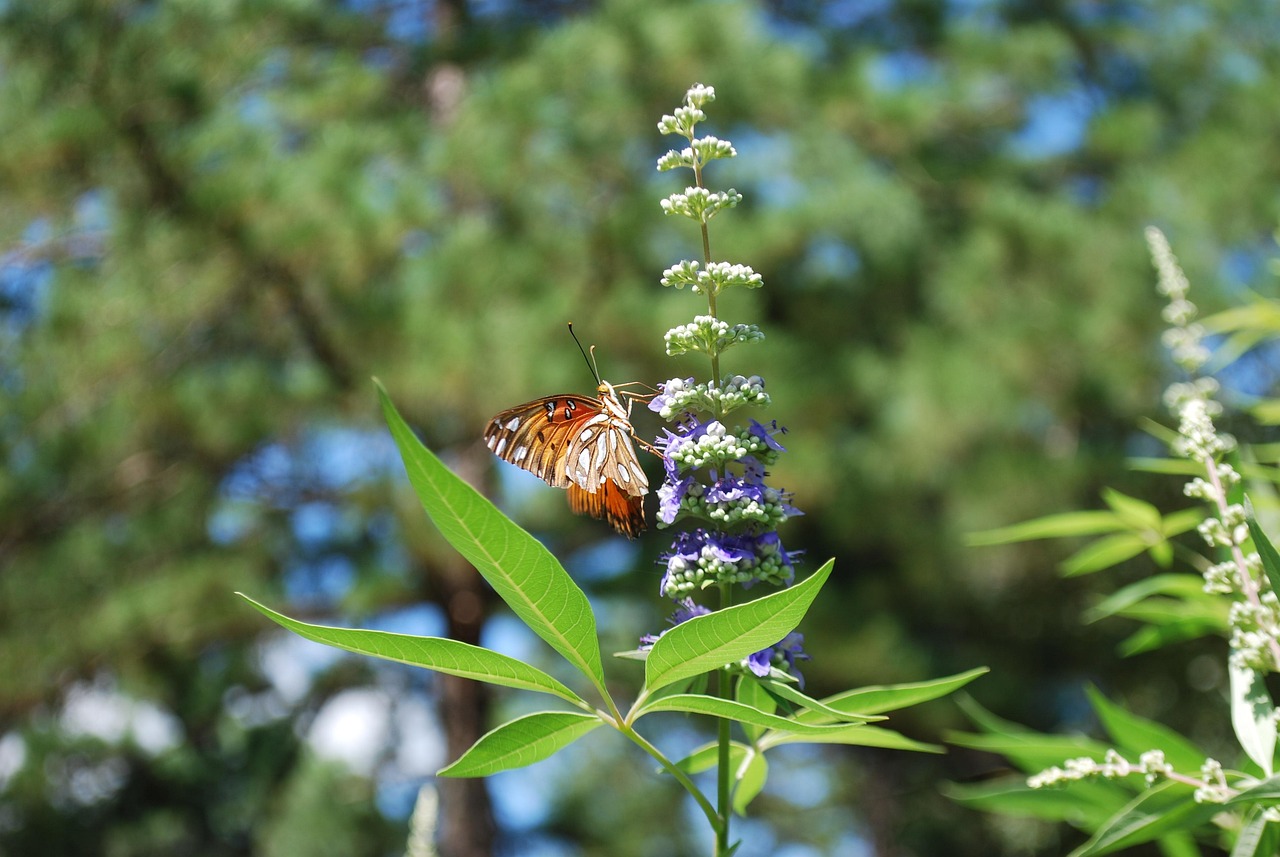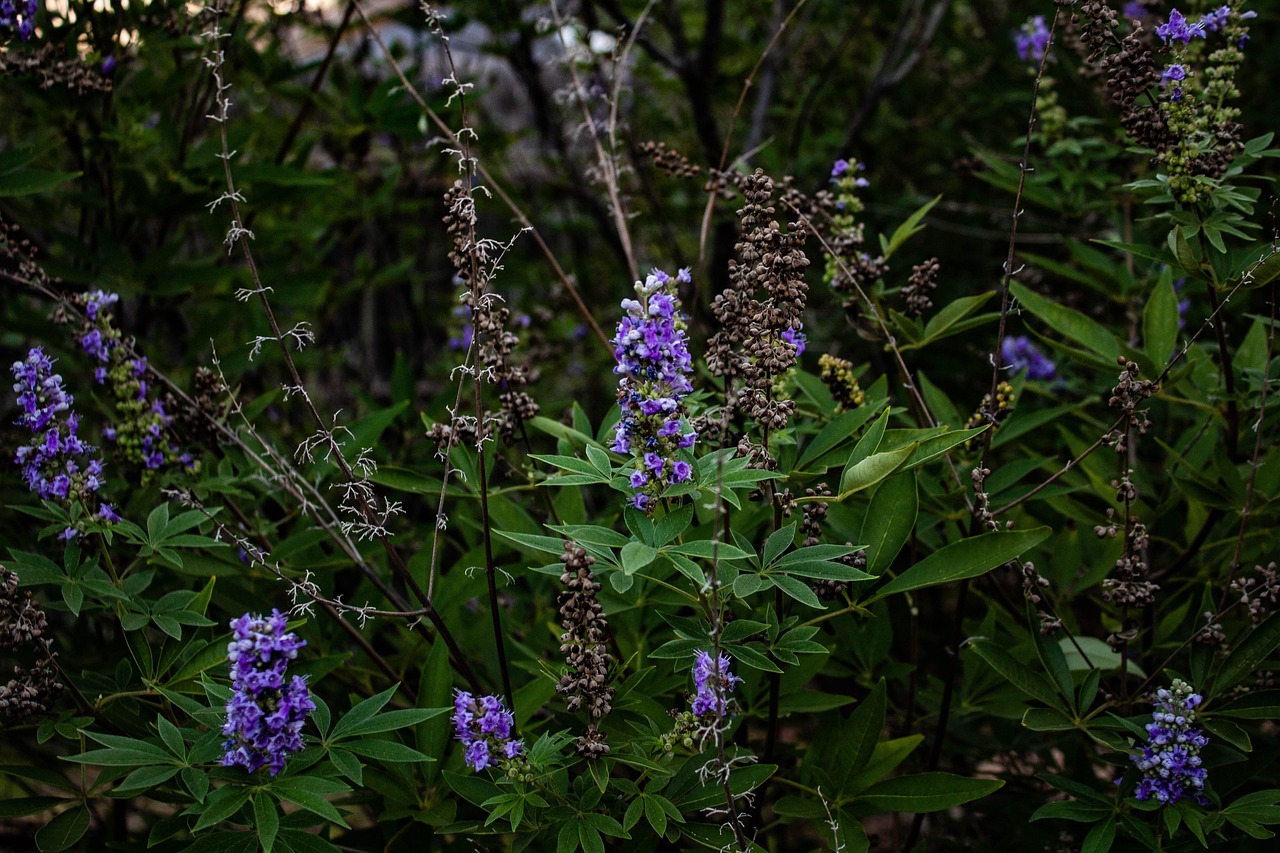The Texas Vitex tree, known for its drought tolerance, typically exhibits a moderate growth rate of about 1 to 2 feet per year under optimal conditions. In xeriscape gardens, where water conservation is key, its growth may slow slightly due to limited irrigation. Proper placement and soil preparation can enhance its growth potential in these landscapes.
The Texas Vitex tree typically grows at a moderate rate of 2 to 3 feet per year, making it an excellent choice for xeriscape gardens where drought tolerance is essential.
Understanding the Texas Vitex Tree
The Texas Vitex tree, also known as Vitex agnus-castus or chaste tree, is a flowering tree native to the southwestern United States. It is celebrated for its vibrant purple flowers and aromatic foliage. This tree is particularly well-suited for xeriscape gardens, which are designed to minimize water usage while still providing beauty and functionality.

Texas Vitex trees thrive in hot and dry climates, making them an ideal choice for regions with limited rainfall. They can tolerate drought conditions once established, which means they require less water than many other ornamental trees. Their growth rate and resilience contribute to their popularity among gardeners seeking sustainable landscaping options.
Growth Rate of Texas Vitex
The growth rate of the Texas Vitex tree can vary based on several factors, including soil conditions, sunlight, and water availability. Generally, the tree establishes quickly in well-drained soil and full sun exposure. Below are some key factors that influence the growth rate:
- Soil Type: Well-draining sandy or loamy soils support faster growth.
- Watering Schedule: Regular watering during the first year helps establish the root system.
- Sunlight: Full sun encourages vigorous growth and flowering.
- Fertilization: Minimal fertilizer is recommended; excessive nutrients can lead to weaker growth.
Ideal Conditions for Growth
To achieve optimal growth rates, it is essential to provide the Texas Vitex tree with the right conditions. Here are some ideal conditions for planting and maintaining this tree:

| Condition | Ideal Requirement |
|---|---|
| Sunlight | 6 to 8 hours of direct sunlight daily |
| Soil Type | Sandy or loamy soil with good drainage |
| Watering Frequency | Weekly watering in the first year; less once established |
| Fertilization | Minimal; use a balanced fertilizer if necessary |
These ideal conditions help ensure that the Texas Vitex tree not only grows at a satisfactory rate but also remains healthy and vibrant in your xeriscape garden.
Factors Affecting Growth Rate
While the Texas Vitex tree has a general growth pattern, several specific factors can either enhance or hinder its growth rate. These include:
- Climate: This tree thrives in hot climates but can struggle in areas with extreme cold or humidity.
- Pest Resistance: The tree is relatively pest-resistant, but certain pests can still affect its health and growth.
- Root Space: Adequate space for roots to expand is crucial for healthy growth.
- Competing Vegetation: Nearby plants can compete for nutrients and water, affecting growth rates.
Understanding these factors can help gardeners make informed decisions about planting and caring for Texas Vitex trees in xeriscape gardens. By providing the right conditions and monitoring environmental factors, you can enhance the growth rate and overall health of your Texas Vitex trees.

Cultivation Tips
To cultivate Texas Vitex trees effectively, consider implementing the following tips:
- Planting Location: Choose a location with plenty of sunlight and minimal competition from other plants.
- Irrigation: Use drip irrigation to deliver water directly to the roots without wasting resources.
- Mulching: Apply mulch around the base to retain moisture and suppress weeds.
- Pruning: Regular pruning encourages bushier growth and enhances flowering.
By following these tips, you can create a thriving environment for your Texas Vitex trees, maximizing their growth potential in your xeriscape garden.
Water Requirements for Texas Vitex Trees
Understanding the water requirements of Texas Vitex trees is crucial for their successful growth, especially in xeriscape gardens. While these trees are drought-tolerant, they still require adequate water during their establishment phase. After the first year, their water needs decrease significantly.

Establishment Phase
During the first year after planting, Texas Vitex trees need regular watering to develop a robust root system. Here are some guidelines:
- Frequency: Water the tree deeply once a week. This encourages roots to grow deeper into the soil.
- Amount: Aim for about 10 to 15 gallons of water each week, depending on soil type and weather conditions.
- Signs of Stress: Look for wilting leaves or leaf drop as indications that the tree may need more water.
Established Trees
Once established, Texas Vitex trees can survive on minimal water. They typically thrive on rainfall alone during the growing season. However, supplemental irrigation can be beneficial during prolonged dry spells.
- Watering Frequency: Reduce watering to once every two to four weeks.
- Soil Moisture: Check the soil moisture before watering; it should be dry at least 2 inches below the surface.
- Mulch Benefits: Using mulch helps retain soil moisture and minimizes the need for frequent watering.
Pest and Disease Management
Texas Vitex trees are generally resilient against pests and diseases. However, some issues can arise that may affect their growth rate and overall health. Recognizing these problems early can help you manage them effectively.
Common Pests
The following pests may occasionally affect Texas Vitex trees:
- Aphids: These small insects can suck sap from leaves, leading to yellowing and curling.
- Spider Mites: These pests thrive in hot, dry conditions and can cause leaf discoloration.
- Scale Insects: Scale can attach themselves to branches and stems, weakening the tree over time.
If you notice signs of infestation, consider using insecticidal soap or neem oil as organic treatment options. Regularly inspecting your trees helps catch these issues early.
Diseases to Watch For
While diseases are less common, Texas Vitex trees can be susceptible to a few conditions:
- Root Rot: Often a result of overwatering or poor drainage, root rot can lead to wilting and dieback.
- Powdery Mildew: This fungal disease appears as a white powdery substance on leaves, particularly in humid conditions.
To prevent these diseases, ensure proper drainage and avoid watering the leaves directly to reduce humidity around the plant. Pruning any affected areas promptly can also help manage outbreaks.
Pruning Techniques for Optimal Growth
Pruning is an essential part of maintaining healthy Texas Vitex trees. Proper pruning techniques promote bushier growth and enhance flowering, contributing to the overall aesthetics of your xeriscape garden.
When to Prune
The best time to prune Texas Vitex trees is during late winter or early spring before new growth begins. This timing allows you to shape the tree without disrupting its flowering cycle.
Pruning Methods
Follow these methods for effective pruning:
- Removing Dead or Damaged Wood: Cut away any dead or broken branches to encourage new growth.
- Shaping the Tree: Trim back excess growth to maintain a desired shape. Focus on creating an open center to improve air circulation.
- Encouraging Blooms: Lightly trim back spent flowers after blooming season. This promotes additional flowering later in the season.
Using clean, sharp tools is essential to prevent injury to the tree and reduce the risk of disease transmission. Always make cuts at a slight angle to allow for water runoff and minimize rot.
Nutrient Requirements
The nutrient requirements for Texas Vitex trees are relatively low compared to other ornamental species. However, providing some basic nutrients can enhance their growth and flowering capabilities.
Fertilization Recommendations
If your soil is poor or lacks organic matter, consider using a balanced fertilizer in early spring. Here are some recommendations:
- Type of Fertilizer: Use a slow-release fertilizer with equal parts nitrogen, phosphorus, and potassium (N-P-K).
- Application Rate: Follow package instructions for application rates based on tree size.
- Organic Options: Compost or well-rotted manure can also provide essential nutrients without the risk of over-fertilizing.
Avoid over-fertilizing, as this can lead to excessive foliage growth at the expense of flowers. Monitoring soil health and making adjustments as necessary will help maintain a balanced nutrient profile for your Texas Vitex trees.
Choosing the Right Location for Texas Vitex Trees
When planting Texas Vitex trees, selecting the right location is vital for ensuring their growth and health. These trees thrive in specific environmental conditions, and understanding these requirements can lead to successful establishment and growth.
Sunlight Requirements
Texas Vitex trees require full sun for optimal growth. Here are some important points regarding their sunlight needs:
- Direct Sunlight: Aim for a location that receives at least 6 to 8 hours of direct sunlight each day.
- Shade Tolerance: While they can tolerate partial shade, reduced sunlight can lead to leggy growth and fewer flowers.
- Exposure Considerations: Avoid planting near tall structures or trees that may cast shadows during critical hours of sunlight.
Soil Conditions
The soil type plays a significant role in the growth of Texas Vitex trees. They prefer well-draining soils that allow for healthy root development. Key soil considerations include:
- Soil Type: Sandy or loamy soils are ideal, as they provide good drainage and aeration.
- pH Level: A slightly acidic to neutral pH (6.0 to 7.0) is best for Texas Vitex trees.
- Soil Amendments: Incorporating organic matter, such as compost, can improve soil fertility and drainage.
Mulching Techniques for Texas Vitex Trees
Mulching around Texas Vitex trees offers several benefits, including moisture retention and weed suppression. Proper mulching practices can significantly enhance the health of your trees.
Benefits of Mulching
Using mulch in xeriscape gardens can provide numerous advantages:
- Moisture Retention: Mulch helps retain soil moisture, reducing the need for frequent watering.
- Weed Control: A layer of mulch can suppress weed growth, minimizing competition for nutrients.
- Temperature Regulation: Mulch insulates the soil, keeping it cooler in summer and warmer in winter.
Types of Mulch
There are various types of mulch suitable for Texas Vitex trees. Consider the following options:
- Bark Mulch: Provides good insulation and is aesthetically pleasing.
- Wood Chips: Effective at moisture retention and weed suppression; ensure they are free from chemicals.
- Straw or Hay: Organic options that break down over time, adding nutrients to the soil.
Application Tips
To effectively apply mulch around Texas Vitex trees, follow these guidelines:
- Depth: Apply a 2 to 4-inch layer of mulch, keeping it a few inches away from the trunk to prevent rot.
- Replenishment: Refresh the mulch layer annually to maintain its effectiveness and appearance.
- Avoid Plastic Mulches: Plastic sheeting can trap moisture and harm tree roots; opt for organic materials instead.
Seasonal Care for Texas Vitex Trees
Caring for Texas Vitex trees throughout the seasons is essential for promoting healthy growth and flowering. Each season presents unique challenges and opportunities for tree maintenance.
Spring Care
Spring is an important time for growth and renewal. Consider these care techniques during this season:
- Pruning: As mentioned previously, prune dead or damaged branches before new growth begins.
- Fertilization: Apply a balanced fertilizer to promote vigorous growth.
- Irrigation: Increase watering frequency as temperatures rise.
Summer Care
The hot summer months require attentive care to ensure the survival of Texas Vitex trees:
- Watering: Monitor soil moisture closely; water deeply if there are prolonged dry spells.
- Pest Monitoring: Keep an eye out for pests like aphids or spider mites and treat them promptly if discovered.
- Mulch Maintenance: Ensure mulch remains in place to conserve moisture.
Fall Care
As temperatures begin to cool, focus on preparing your Texas Vitex trees for winter:
- Final Pruning: Make any necessary adjustments to shape the tree before dormancy.
- Irrigation Adjustments: Gradually reduce watering as rainfall increases in fall.
- Pest Control Measures: Address any lingering pest issues before winter sets in.
Winter Care
While Texas Vitex trees are relatively hardy, some winter care is beneficial:
- Protection from Freezing Temperatures: In areas with occasional frost, consider wrapping young trees with burlap or frost cloths.
- Avoid Excess Watering: Reduce watering significantly during dormancy; overwatering can lead to root rot.
- Pest Inspection: Inspect the trees for any signs of pests that may have survived the colder months.
Caring for Texas Vitex trees seasonally helps ensure their health and longevity. By following these guidelines, you can enjoy flourishing trees that contribute beauty and resilience to your xeriscape garden.
Common Varieties of Texas Vitex
Texas Vitex trees come in several varieties, each with unique characteristics that can enhance your xeriscape garden. Understanding these varieties can help you choose the best fit for your landscape.
Popular Varieties
- Vitex agnus-castus ‘Montrose’: This variety is known for its compact size, typically reaching about 8 to 10 feet in height. It produces abundant lavender flowers and is well-suited for smaller gardens.
- Vitex agnus-castus ‘Shoal Creek’: This larger variety can grow up to 15 feet tall. It features striking blue-purple flowers and a more open growth habit, making it a beautiful focal point in larger landscapes.
- Vitex agnus-castus ‘Lilac Mist’: A more recent introduction, this variety has soft, lilac-colored flowers and a more shrub-like form, ideal for creating hedges or privacy screens.
Choosing the right variety depends on your garden’s space and aesthetic preferences. Each variety offers unique flowering patterns and growth habits that can complement different landscaping styles.
Combining Texas Vitex with Other Plants
Integrating Texas Vitex trees with other plants can enhance the overall beauty and function of your xeriscape garden. Consider companion planting to improve aesthetics and biodiversity.
Companion Planting Suggestions
- Native Grasses: Pairing Vitex with native grasses like Blue Grama or Gulf Muhly can provide a natural look and attract pollinators.
- Drought-Tolerant Perennials: Flowers such as Black-Eyed Susans or Mexican Sage complement the Vitex’s blooms while thriving in similar conditions.
- Ground Covers: Ground covers like Lantana or Sedum can help retain moisture in the soil while preventing weed growth around the base of the Vitex trees.
This combination not only enhances the visual appeal of your garden but also supports local wildlife, including beneficial insects and birds.
Benefits of Texas Vitex in Xeriscape Gardens
The Texas Vitex tree offers numerous benefits that make it an ideal choice for xeriscape gardens. These advantages extend beyond aesthetics, contributing to environmental sustainability.
Environmental Benefits
- Drought Resistance: Texas Vitex trees require minimal water once established, making them perfect for dry climates.
- Pollinator Attraction: The vibrant flowers attract bees, butterflies, and other pollinators, promoting biodiversity.
- Soil Erosion Control: The extensive root system helps stabilize soil, reducing erosion and improving water retention.
Incorporating Texas Vitex trees into xeriscape gardens not only creates a visually stunning landscape but also fosters a healthier ecosystem.
Final Thoughts
The Texas Vitex tree is a remarkable addition to any xeriscape garden. With its moderate growth rate, vibrant flowers, and low water requirements, it stands out as an excellent choice for sustainable landscaping. Understanding its needs regarding sunlight, soil conditions, and seasonal care will significantly enhance its performance in your garden.
By selecting the right variety and combining it with complementary plants, you can create a dynamic and resilient landscape. The environmental benefits of Texas Vitex trees further solidify their place as a favorite among gardeners who prioritize sustainability and beauty.
Overall, embracing Texas Vitex trees in xeriscape gardens not only promotes individual plant health but also contributes positively to the surrounding ecosystem. As you plan your garden, consider how these trees can thrive alongside other drought-resistant plants to create a lush, vibrant space that thrives in harmony with nature.
